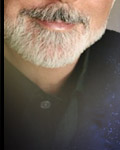|
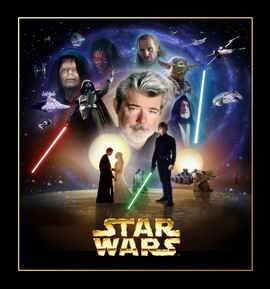
The Essence of Star Wars
– this is the title of my favorite poster. You can see that it tries
to reach a very high peak: it tries to summarize and express the
deepest meaning of Star Wars. The most striking part of the picture
is clearly Lucas in the middle. I have been making pictures for ten
years, I have made more than four hundred pictures; nevertheless,
this is the first piece on which you can find Lucas. Its time has
only now arrived, after so many other works. The meaning of this
element is more than he is the creator of the saga. This picture
wants to enlighten the connection between the creator and his
creation, the message what he wanted to tell through his story. Star
Wars has many fans worldwide; however, only some of them might think
about the fact that it is a creation of a man whose work had a
purpose. And this end was not making a blockbuster or simply
becoming rich. He had a message what he wanted to show to the world
in the form of a complex story. He has spent 30 years of his life to
deliver this message perfectly. During these years, he had a heart
attack and his wife divorced him, making him to live alone until
2007. We might assume he had a serious message. Fortunately, Bill
Moyers made a deep interview with Lucas at Skywalker Ranch in 1999.
This was the year when The Phantom Menace launched – the
movie generally thought to be the most childish one. The fact is,
however, that this movie contains a lot of serious thoughts which
lay down the basis of the whole saga. In the aforementioned
interview, Lucas points to very deep connections in Star Wars;
literally, to the essence of the story. At this point I advise my
visitors to read this interview
here. It will make much
easier to understand my poster because it is the visualization of
this interview.
Lucas’s purpose was
primarily to recreate the ancient myths of mankind in a modern form
– the myths that told the everlasting values of different cultures.
He wanted to create a new myth which is a synthesis, an essence of
the old ones. This myth teaches the younglings the most important
things in life like friendship, loyalty or the ability of letting
things go, not to insist on our interests adamantly. It teaches us
to have respect for the other people because we must see that we
have a common life, we are one. Every single man is responsible for
his/her own decisions; we all have the weapon of choice. Some people
say these are crusty things but Lucas thinks somebody must tell them
to our children in this world where all the ancient myths are
powerless. And there is a greater mystery: there are things beyond
human being, beyond everyday life. There is something or somebody
over mankind.
Most of these aspects are
portrayed through the example of Anakin and Luke in Star Wars.
Anakin betrays friendship and his order then he falls and suffers
the consequences of his acts. Luke refuses to turn to the dark side
and this way he saves his fallen father. The greater mystery is the
Force, of course; it is a representation of God in some way. Its
purpose is to make the children think about God: does he exists or
not? This might be surprising for some fans but that is true: Lucas
himself declares that in the aforementioned interview. He believes
in the power of faith; that is why he uses so many faithful phrases
in the Star Wars movies like ‘Trust your feelings’ or ‘Use the
Force’. You can find the bases of many religions in the saga; Lucas
did not select any of them. It is up to the audience. For Lucas, the
most important part is the faith itself: the faith in ourselves and
in somebody/something who is watching over us.
After this long
introduction, let us talk about the poster itself. We can see the
surface of Tatooine with a bluish galaxy whirling in the background.
Lucas is in the middle of the picture, surrounded by some characters
of the saga and spaceships. The dominant feeling is harmony: the
picture sheds a soothing mood with its mostly bluish but in some
parts yellow-orange shades. Twin suns of Tatooine enlighten the
desolate surface of the planet. Desolate surface with a gorgeous,
shining galaxy behind it: here is the greater mystery. There are
definitely more than everyday life. You might notice a hemisphere
floating above the surface (under Vader) which is a part of the Lars
farm. You can see a vaporator on the right side of the picture,
fading also into the shadows just like they were only visions. The
galaxy and the suns are much more visible and clear than the world
you should see normally - because this is not the true nature of
things. As Ben said in Episode IV when Luke used the Force for the
first time: ‘You have taken the first step into a larger world’. (I
have two reasons why I used only Tatooine from the many planets we
see in the saga. First, this is the oldest, most authentic location
of Star Wars. The second is that Lucas himself thinks this place has
the ‘true’ Star Wars feeling.)
Sith are placed left to
Lucas while you can see the Jedi on his other side. Luke stands on
Tatooine but he takes part in the surrounding figures, too. Artoo is
directly under Lucas. Qui-Gon and Darth Maul are on the top of the
picture; Yoda and Palpatine are below them; then Obi-Wan and Vader
follow. Qui-Gon is the ‘perfect’ Jedi, Yoda watches the Force with a
look full of knowledge. Obi-Wan is prepared for the largest and last
task of his life. Maul stares at us with his devilish eyes.
Palpatine’s position distorts the harmonic arrangement of the
figures (the balance). Vader stands satisfied, being aware of his
powers. Three Sith, three Jedi: three duels; all of them won by the
evil. The fight between Good and Evil, their everlasting circle is a
crucial motif of the whole Star Wars saga. The background of the
figures is the Force itself: the blue star whirl. Because this
galaxy is not only the Star Wars galaxy; it is the representation of
the Force. This way I depict the Force as a character of the saga; a
character larger than any others. If you look carefully you can
notice a small green star next to Qui-Gon, in the middle line of the
poster. This is a part of the Force, too. If I would like the theory
of the Living and Unifying Force, I would say this is the Living
Force, very close to Qui-Gon because he had the largest knowledge
about it. The other parts, the large blue starfield could be the
Unifying Force which was in the focus of Obi-Wan. But I do not like
this theory because it divides the Force. Therefore, I used Yoda’s
words as an inspiration of the representation of the Force: ‘It
surrounds us, and binds us’. That is why it is depicted as a
whirling, shining galaxy. When I chose its color scheme, I had four
options theoretically: blue, green, white or colorful. This last one
would result in a really chaotic background without any reference to
unity therefore I omitted it immediately. White is too simple and it
is a strange color for a Star Wars poster. Green would be a wiser
choice as ‘life creates it (the Force), makes it growth’ but green
would exclude the non-living part of the world. On the other hand,
blue is perfect: it represents infinity (blue sky, blue ocean), it
is calming and it also refers to life indirectly. Moreover, water
surrounds any living and non-living things like the Force does in
the galaxy of Star Wars. (There is another thing: blue is the color
of the Force-lightning, the most powerful visual manifestation of
the raw power of the Force.) Nevertheless, I wanted to refer somehow
to the fact that the Force flows from life that was why I put the
small green star next to Qui-Gon. The small size of the green star
is in great contrast with the huge galaxy and refers to Yoda’s words
again: ‘Size matters not’.
I must admit this is a very
complex symbolism but also very meaningful, I think. Because it
gives a new explanation to Vader’s power-desiring pose: he looks
like if he would catch the green star, the secret of life and the
way to defeat death. But he cannot have it as a Sith; Qui-Gon gets
it firstly; he is the closest one to the star. You can see that
Vader’s aura is red (look at his hand), very far from the green
color; actually, the superposition of green and red gives black - he
has no chance to get the secret.
The aura colors of the
other characters are also important. In the case of the Jedi, colors
change from Qui-Gon’s green tones to Obi-Wan’s soft blue aura,
depending on how close the character to the understanding of the
Force is. This property determines the position of them, too: the
higher the position the higher the understanding.
Palpatine is a special
character. His aura is hard to see because it is deep blue, merging
to the color of the Force and symbolizing how powerful Force-user he
is. His figure stands out of the ring formed by the others and he is
larger than them, representing that the Force is not in balance -
because of him; he is the tremor in the Force.
Darth Maul, as the Sith
apprentice, has no aura because he has not got a fully developed
personality, he is like a half full jug, filled by his master’s soul
mostly. Nevertheless; he does not need an aura because his
appearance is enough to create the mood of darkness and fear around
him, without being really repulsive. (According to Lucas, he is the
manifestation of the evil within us.) Note that he has a higher
position than Vader because he was possessed by the dark side more
than Vader. Maul never was good like Anakin. On the other hand,
Vader always carries a small piece of Anakin.
And now about Luke… He has
a yellow aura like Lucas – this phenomenon binds them together and
this might be the most important part of the picture (and the whole
saga, too). And the reason is that Lucas shows the good decisions
mostly through Luke’s acts. Luke is Lucas’ idealized representation
in the saga (note their similar names). That is why Luke stands in
front of anyone else and that is why they have the same yellow aura.
This color refers to completeness and it is qualitatively different
from the traditional Jedi-Sith color representations. He is the only
one who stands on the ground. He can sense and he lives the two
worlds simultaneously: the everyday one and the one beyond it.
(Remember the end of Return of the Jedi when Luke takes his
farewell to his father, watches the Jedi ghosts and then joins the
Rebel celebration.) Moreover, Luke did something what have never
been done by others in the saga. He had the experience of the
“gifts” of the dark side and he refused consciously, being aware of
them. Jedi always kept distance from the dark side. No doubt it
needs fortitude but Luke looked at the deeps of the dark side and
then he said, throwing his weapon away, ‘You have failed,
Your Highness. I am a Jedi, like my father before me’. He is
greater than his father now, greater than any Jedi. Because he came
to know the darkness and it did not seduce him. Luke knew what he
refused, not like the other Jedi. He was determined even to die.
This act needs greater powers than to say no something you do not
know, I think. With this act, he saved his father. And now we are at
Lucas’ another very important point. He thinks that one of the most
important tasks in life is raising children that will bring out the
best of you. In the Star Wars saga: Anakin has fallen and he is
unable to redeem himself alone. His atonement seems to be
everlasting – but he has a son. His son can redeem his father
through the good in him (Luke), through his own force. He brings out
the best of his father. Father and son, so similar characters; even,
they are very different. Remember Ben’s words from the Jedi
script: “To be a Jedi, Luke, you must confront and then go beyond
the dark side - the side your father couldn't get past. Impatience
is the easiest door - for you, like your father. Only, your father
was seduced by what he found on the other side of the door, and you
have held firm.” Their pose, their cloth colors are very
similar on the poster; nevertheless, they express different things.
Vader is menacing, power-hungry while Luke is calm, self-confident,
balanced. But their sabers are parallel. Both of them take the
hero’s journey: Anakin is a fallen hero, Luke is a triumphant one.
This is another key point: the hero that recognizes his fate, stands
the task and measures up to it.
I have not mentioned the
figures on the planet yet. We can see Shmi taking her farewell to
his son before the pod race. This intimate scene is about release,
the recognition of that things have their order that cannot be
interfered. Anakin’s fate is to help Qui-Gon and his friends which
means he has to win the race. His mother realizes this and she is
able to let her son go. This is symbolized by the position of the
sun: Anakin and his pod are inside while his mother is outside the
glory of the sun. (The pod itself is a hint to Lucas’s devotion to
races and cars – see American Graffiti. He also wanted to
enlighten the connection of man and technique in Star Wars.) We can
see Padmé’s wedding on the other side of the planet. This is about
clamber together which leads to Anakin’s fall although it started
beautifully. You can notice that their figures lead through the sun
into Vader. I suppose this connection depicts Lucas’ real-life
relations to women as well as the fact that you can hardly see
memorable women in the six films other than Padmé and Leia. In fact,
we cannot see truly happy love in Star Wars: Anakin’s relation to
Padmé comes to a terrible end while Leia and Han are not so close to
each other even in Jedi.
We can see Artoo right
below Lucas, now without Thripio because Lucas has a special
connection with Artoo. He declares himself a big Artoo fan in the
audio commentary of Episode III. The first close-up of Episode II
shows Artoo’s dome. Moreover, Artoo is the one who tells the story
of the saga in that galaxy far, far away: 100 years after Jedi,
Artoo meets with a Whill Chronicler and tells him everything what we
see in the movies. He knows all the secrets; he was there at every
important thing.
It is important to see
that, in some things, this picture relays opinions not fully mine,
in contrast with all my other works. Here I wanted to tell what a
creation can mean to its creator. My opinion is very close to Lucas’
but I would have made some things differently if I wanted to depict
my thoughts about Star Wars.
Some people would miss Leia
from this picture. But take a look at his importance in Lucas’
terms: he has little care for her. The fact that she is Anakin’s
daughter has almost no importance in the saga (practically, it is
used only in one scene). She belongs more to the Rebels than to the
Force; she is not a speaking-tube of Lucas, in contrast with, for
example, Shmi. (Shmi is aware of the necessity of change.)
Finally, I would like to
mention that some of the motifs of this poster, like Luke, Vader and
the planet surface, have already appeared on my other pictures. The
reason is that I had this theme on my brain for several months until
I reached the level on that I was able to express it in a satisfying
way. In the case of Vader’s Triumph, everything was Vader: he and
his surroundings, too, because the latter was the representation of
his soul. On this new poster, everything is Lucas. Because
everything that surrounds him is his creation – on some level, they
are himself. My Luke poster (‘I am a Jedi’) can be considered as the
younger brother of this one as they show many similar things,
according to the Luke-Lucas parallelism.
This poster is a
summarizing work therefore it is obvious to compare it with my saga
poster. That one summed up many small and beautiful aspects of the
saga while this new one focuses on the most important parts, the
deepest thoughts. I think this one is better; nevertheless, I am
sure its popularity will never reach the level of the saga poster.
MOYERS: I hear many
young people today talk about a world that's empty of heroism, where
there are no more noble things to do.
LUCAS: Heroes come in
all sizes, and you don't have to be a giant hero. You can be a very
small hero. It's just as important to understand that accepting
self-responsibility for the things you do, having good manners,
caring about other people--these are heroic acts. Everybody has the
choice of being a hero or not being a hero every day of their lives.
You don't have to get into a giant laser-sword fight and blow up
three spaceships to become a hero.
Making of „The
Essence of Star Wars”
In this section, I show you
the making of this poster. Its working title was simply ‘Lucas’. I
changed it to ‘Essence’ at the end which title was later expanded to
‘The Essence of Star Wars’.
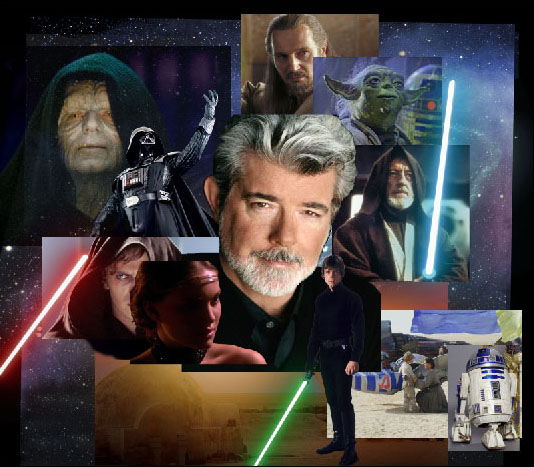
This is the first stage.
Figures are not cut into their final forms but the composition is
almost final. Artoo has not clear position; I just put him there to
not forget him. However, the lightsabers are ready.
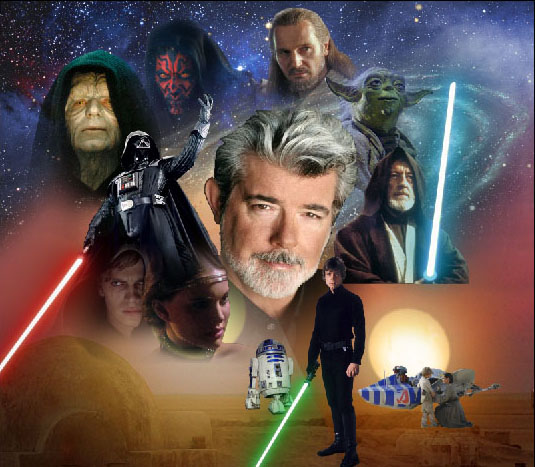
Now, picture element cuts
are ready and you can see that I use a temporary background. I often
use such backgrounds for complex pictures with almost finalized
color scheme. The aim is to relay the planned final mood of the
picture which helps me in forming the composition. In a later stage,
I replace this background with a final one.
Artoo has its final
position and the pod scene is practically completed. You can see
that the green star next to Qui-Gon is blue and is not at its place.
But the most interesting part might be the Anakin-Padmé part instead
of the wedding scene. I used this Padmé picture originally because
this costume of her was designed by Lucas himself but this element
did not work. Its dark colors did not match with the sun in the
background therefore I decided to change this part.
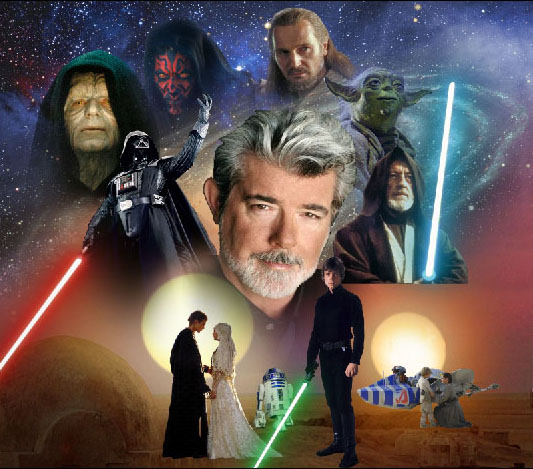
Now the wedding scene
rhymes well with the pod scene. I admit at this point I had an idea
to put Lucas into one of the suns but I immediately dropped it
because it would be too direct. It would look like Lucas were a God
and it also would weaken the complex message of the picture by
underlining only one aspect.
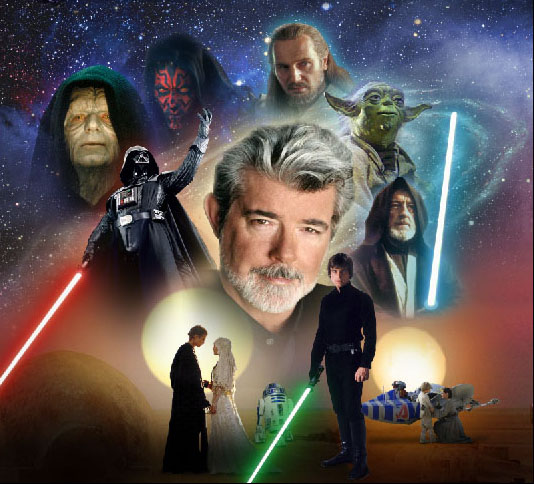
You can see little
difference between the previous one and this stage but the figures
have their auras now, except Luke. At this point, I was not sure
about what color should I use in his case, how dominant it should
be. Obi-Wan is almost completed here.
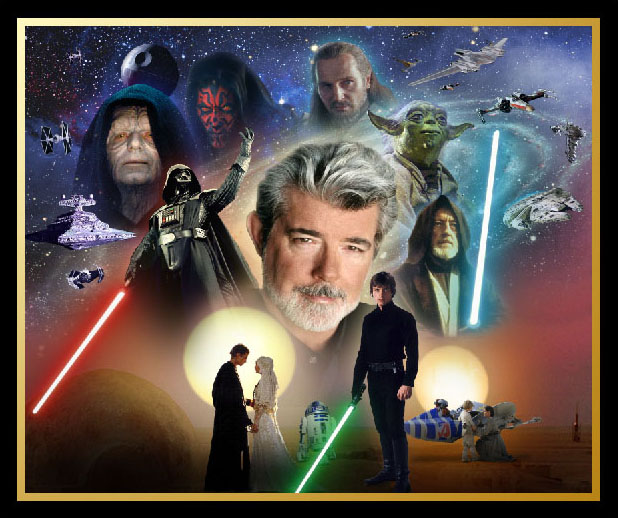
Additional picture elements
like spaceships are there (note the Nebulon-B frigate) and Luke’s
yellow aura has been finished. I tried a wide gold frame which is
not really good, I think. The background is still temporary which is
really unusual – I usually change to the final one earlier.
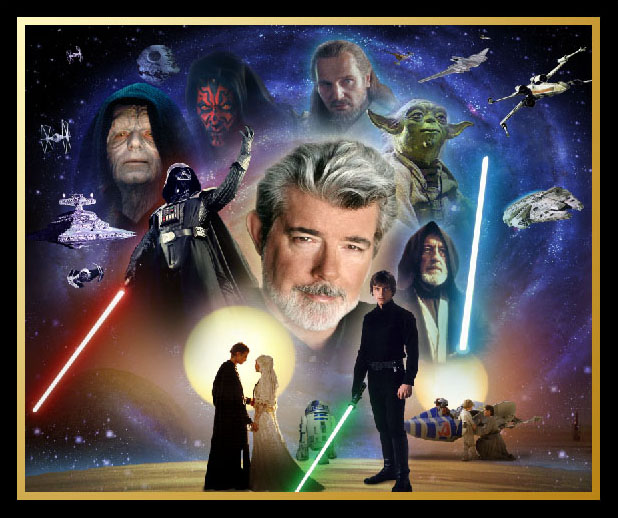
So here is the almost final
version of the background which is the last and largest character in
this case: the Force. You can clearly see the mood difference
between this version and the previous ones. I decided here to make
the blue color more dominant. The idea to use a planet surface
instead of the Tatooine landscape came at this point, too. These two
elements form the main opposition of the picture beautifully: galaxy
vs. planet, large vs. little, infinite vs.
usual. Note that I removed the blue star at this point.
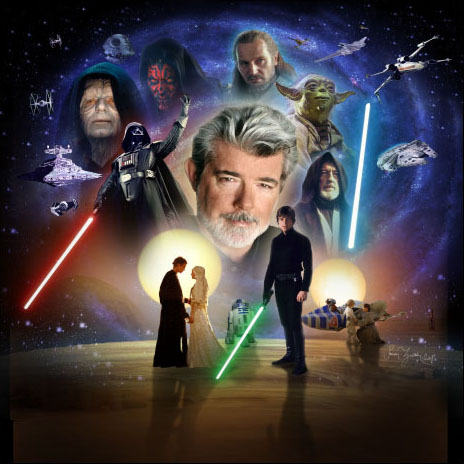
Two important modifications
were made on this one: I removed the frame and I extended the size
of the canvas in order to improve the balance of the picture. You
can see my signature there, too. I put the reflection of the figures
onto the planet surface to make it more unrealistic. Note that
everyone has a simple shadow; however, the planet has two suns.
Nevertheless, you never see double shadows in the movies therefore
you do not see them here.

And here is the final
version. It has an elegant frame, it has the STAR WARS logo and you
can find the green star here, too. I printed the version without
logo, framed it and hanged it in my room.
|
